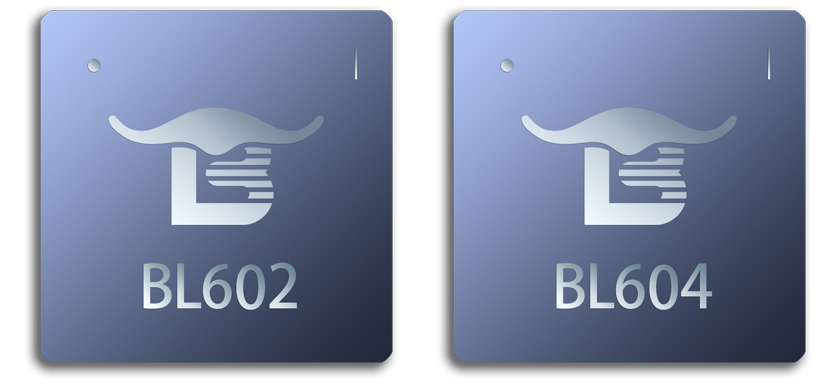BL602/BL604 
IoT Wi-Fi and Bluetooth5(LE) Combo
BL602 is an IoT chip that supports multiple security mechanisms, low power consumption, low cost and high performance. The chip has a built-in RISC-V 32-bit single-core processor, has rich cache and memory resources, integrates a variety of peripherals, supports Wi-Fi and BLE combinations, and provides industry-leading single-chip multi-purpose solutions for IoT products. Suitable for a wide range of IoT application scenarios.

The BL602 has a built-in RISC-V 32-bit single-core processor with a clock frequency of up to 192MHz, including 64 interrupts and an interrupt controller with 16 interrupt levels/priorities for low-latency interrupt processing. With 276KB RAM / 128KB ROM / 1Kb eFuse, support external Flash. A variety of integrated peripherals and rich GPIO pins meet the functional requirements of various IoT products. In addition, the operating temperature of -30°C~105°C also expands the application scenarios of BL602.

The BL602 integrates 2.4 GHz Wi-Fi and long-range Bluetooth 5 (LE), supports simultaneous access to multiple clouds, supports Bluetooth Mesh, and maintains excellent RF performance at higher operating temperatures, helping build IoT devices and solutions with wider coverage and more powerful application functions.

BL602 supports the use of ECC-256 signed images to provide secure boot protection; supports QSPI/SPI Flash instant AES decryption (OTFAD), supports AES128 CTR mode, supports AES 128/192/256-bit encryption engine to ensure secure device connection; provides public key Accelerator (PKA), supports basic operations of large numbers, and the software provides signature, verification, etc. to ensure the security of the application program interface.

BL602 uses the IoT development framework BL_IOT_SDK. BL_IOT_SDK has undergone rigorous application testing and has been successfully applied to tens of millions of IoT devices. Based on its mature and clear software architecture, complete API and easy-to-use tools, developers will be easier to build BL602 applications or port solutions to other platforms. The Wi-Fi SDK of BL602 supports Wi-Fi client mode, access point mode or coexistence mode. Together with the BLE SDK, it builds rich IoT connection functions and realizes more smart interconnected applications.

| CPU | 32-bit RISC-V CPU |
|---|---|
| RAM | 276KB RAM, 128KB ROM, 1Kb eFuse and Configurable Embedded Flash Flash |
| Cache | 32KB L1 Cache |
| Performance | 1.46 DMIPS / MHz |
| Efficiency | 3.1 CoreMark / MHz |
| Security function | ■ Secure Boot with support for images signed with ECC-256 ■Secure debug port ■QSPI/SPI Flash instant AES decryption (OTFAD), AES128 CTR mode ■AES 128/192/256 bit encryption engine ■SHA-1/224/256 ■True Random Number Generator (TRNG) ■Public Key Accelerator (PKA), supports basic operations of large numbers, and the software provides application programming interfaces such as signature and verification |
| Security hardware | TrustZone |
| Wireless protocol support | IEEE 802.11 b/g/n, Bluetooth 5.0 low energy, Bluetooth Mesh |
| Wireless data rate | MAX WLAN TX/RX MCS7 ;MAX BLE TX/RX 1Mbps |
| TX power | 0-21 dBm |
| RX sensitivity | Bluetooth Low Energy: Typical: -97 dBm at 1Mbps; Maximum: -92 dBm at 1Mbps |
| RF power consumption at 3v DC/DC | BLE RX MIN: 31 mA BLE TX MAX: 133 mA WLAN RX MIN: 39 mA WLAN TX MAX: 310 mA |
Support Wi-Fi/BLE wireless interconnection function. The development board has a wealth of peripherals, and users can easily realize product development.
The development board supports the function of automatic programming. The development board leads out the JTAG pin, which is convenient for users to debug the program.
BL602-IoT-DVK-3S leads out key GPIO ports for users to use. In addition, the exported GPIO port can be multiplexed into SPI/I2C/PWM/UART and other functions
Support Wi-Fi/BLE wireless interconnection function. The development board has a wealth of peripherals, and users can easily realize product development.
The SDIO interface in the BL604E-IoT-DVK is led out by means of golden fingers, which is convenient to connect with other platforms.
BL604E-IoT-DVK leads out key GPIO ports for users to use. In addition, the exported GPIO port can be multiplexed as SPI/I2C/PWM/UART and other functions
The BL-HWC-G1 development board consists of two core systems: BL602 hardware system and BL706 hardware system. BL602 is a Wi-Fi+BLE Combo chip, and BL706 is a BLE5.0 + Zigbee3.0 Combo chip.
The SDIO interface in the BL604E-IoT-DVK is led out by means of golden fingers, which is convenient to connect with other platforms.
Four types of female sockets are preset to adapt to common standard sensor modules on the market. The functions that can be realized through software configuration are as follows: (1) USB-to-UART bridge chip, which can be used for chip programming and system debugging; (2) Reset button and boot mode control button; (3) Support automatic download function; (4) Support peripheral sensors such as I2C, SPI, UART and PWM; (5) Support WiFi/BLE/Zigbee through simple hardware modification Gateway development (6) Support JTAG+GDB debugging function
BL_IOT_SDK has undergone rigorous application test and has been successfully applied to tens of millions of IoT devices. Based on its mature and clear software architecture, complete API and easy-to-use tools, developers will be easier to build wireless interconnection applications of chips. Using BL_IOT_SDK can help you quickly develop related applications focusing on wireless interconnection, obtain compact code, save development time, and speed up product launch.
BL_MCU_SDK is rich in content and complete in functions. It has undergone rigorous application testing and has been successfully applied to tens of millions of IoT devices. Based on its mature and clear software architecture, complete API and easy-to-use tools, developers will be easier to build chip applications or port solutions to other platforms. The porting and application work of RTOS / LVGL / TFLite in the SDK also helps developers develop in-depth AIoT applications.
info@bouffalolab.com
support@bouffalolab.com
5F, Block A, Shared Space, No.9 Yunzheng Street, Research and Innovation Park, Jiangbei New District, Nanjing